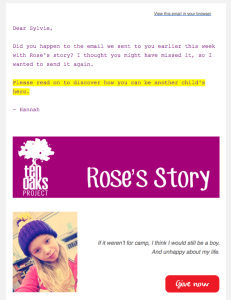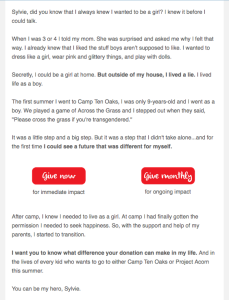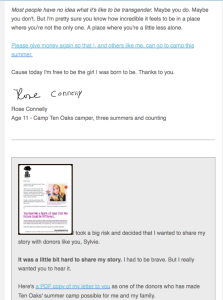Ah, storytelling… Its very power is undeniable.
 It’s got an irresistible pull because it’s such an important part of our lives, and, if you really think about it, nothing beats a great story. Creating unforgettable stories that leave an everlasting impression in your donors’ minds (and hearts) is a crucial component of successful fundraising. Why? Because a fantastic story doesn’t only delight, inspire, and emotionally affect your readers in a meaningful way. Stories also have the power to transform readers into donors who give, and give often.
It’s got an irresistible pull because it’s such an important part of our lives, and, if you really think about it, nothing beats a great story. Creating unforgettable stories that leave an everlasting impression in your donors’ minds (and hearts) is a crucial component of successful fundraising. Why? Because a fantastic story doesn’t only delight, inspire, and emotionally affect your readers in a meaningful way. Stories also have the power to transform readers into donors who give, and give often.
Stories have the ability to spur people into action.
Case in point. In the following email, Ten Oaks Project has shared with us the story of Rose, a young transgendered girl and Camp Ten Oaks camper for three years in a row. For Rose, their camp was no ordinary summer escape, for the impact it had on her life was profound. You could even say her experience was life-changing. I’m pretty sure Rose would agree with you.
The Ten Oaks Project is a volunteer-driven Canadian organization that engages and connects children and youth from LGBTQ+ (lesbian, gay, bisexual, trans, two-spirit, queer) families, identities, and communities.
You see, Camp Ten Oaks was a safe haven where Rose realized she could finally live the life she wanted and find her own sense of happiness. Ten Oaks Project has shared Rose’s life-changing experience through telling her story in such a heartfelt, emotional way, that it’s bound to tug on your heart strings just a little bit.
Or maybe a lot. I confess, this one had me reaching for my Kleenex by the end (click the images to read the email).
Again, stories spur people into action. And no one knows this better than Ken Burnett, author of the masterful new book, “Storytelling Can Change the World.” In it, he explains the power of transformational storytelling — what this skill is, why it’s important, and how to achieve it.
Ken says that transformational storytelling involves telling stories for the purpose of creating positive change — making something or someone better. Sounds pretty powerful, doesn’t it? Through sharing Rose’s story with an audience of potential donors, that’s exactly what Ten Oaks Project is doing — and doing well. How?
Well, Ken explains five key stages of storytelling structure in his book, and Rose’s story hits every single one of these points, and then some. Her narrative has been carefully crafted into a memorable, emotionally compelling story. Seeing how important the structure of the piece is will not only help you understand why Rose’s narrative is so amazing, but will also provide insight on how YOU can masterfully tell your own stories in an effective way.
If it’s your goal to write stories that inspire real change, then these five key stages are your holy grails. Ken names engagement, involvement, inspiration, influence, and action as key – and Ten Oaks Project nails them all.
Engagement is the ability to simultaneously capture the attention and emotion of the reader. Rose’s story grabs your attention and emotion from the get go, doesn’t it? The heading — the very first thing you see — reads, “Will you be my hero?” It’s an emotional plea that sounds very much as if it’s coming from a vulnerable place. And then, delving into the body of the message, you encounter the first sentence: “Did you know that I always wanted to be a girl? I knew it before I could talk.” That captures your attention, doesn’t it? And it brings us to the next key stage…
Involvement! The opening line sets the backdrop scene for Rose’s narrative and, in just hearing a new voice enter your consciousness, you instantly crave to know more and are engaged from the start. Who’s speaking? Why does she need a hero and why has she always wanted to be a girl? Naturally, you’re compelled to read on to hear the rest of the story because you’ve become emotionally invested, not to mention very curious.
And in reading on, you’re inspired. The third key stage of transformational storytelling is inspiration and this story decidedly makes the grade. Rose’s narrative is one of self-discovery. It’s a coming of age tale and, simply put, a joy to read. How positively wonderful is it to hear that this little girl found hope and happiness, after not being able to be herself in public and feeling all alone? Her journey is nothing short of inspiring.
The fourth key stage is influence. Effective storytelling has the power to influence readers. In using the word, Ken is talking about how stories can have the ability to shape the thinking, feeling, and intentions of the reader. Emotions inform thought, and Rose’s story is very emotional. Emotion is frequently the driving force behind decision-making processes, including the case of making a gift. The story also influences the reader because of its sheer relatability factor. Maybe you aren’t transgendered. But maybe you’ve felt alone before. Maybe you’ve been hindered from living your life the way you want to. Maybe you’ve felt like you don’t belong. Maybe you want to make a life change but you’re lost as to how… There are countless ways this story is relatable, depending on who the reader is and how they spin it.
And lastly… The previous four key stages harness all the emotion, feeling, thinking, and inspiration into one compelling bundle and makes readers want to act on it by making a gift to Ten Oaks Project. Action is the last key stage and this story doesn’t just ask for a gift so that Rose, and others like her, can continue to enjoy summer camp — and their freedom to be who they were meant to be. There is so much that comes before the ask that compels the reader to give. The ask really just seals the deal. And the cherry on the top of the sundae is the “Thanks to you.” The gift is not only appreciated but makes it all possible. Ah, the power of the individual…
How are you creating your organization’s transformational stories? Registration for Nonprofit Storytelling | The Basics & More™ is open now.




















 I can’t wait to meet with you personally.
I can’t wait to meet with you personally.
Comments on this entry are closed.